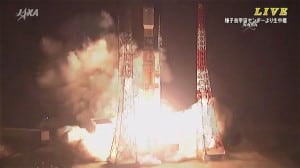Latest News
[Via Satellite 08-20-2015] On Aug. 19 an H2B rocket from the Japanese Aerospace Exploration Agency (JAXA) and Mitsubishi Heavy Industries (MHI) successfully launched the H-2 Transfer Vehicle (HTV) 5 to the International Space Station (ISS), delivering more than 4.5 tons in supplies including food and water, equipment, and small satellites. Among SmallSat operators, Planet Labs is one of the biggest beneficiaries of the latest launch. Planet Labs has 14 “Dove” CubeSats aboard, which comprise Flock 2b.
The HTV 5 further stabilizes activity for the ISS and Planet Labs after three launch failures: one of the Russian Progress M 27M vessel, one of Orbital Sciences, now Orbital ATK’s Antares rocket, and one of SpaceX’s Falcon 9 rocket. The Antares launch failure destroyed 26 Planet Labs satellites, and the SpaceX CRS 7 failure claimed another eight. The company’s 101st satellite is onboard HTV 5, awaiting deployment by NanoRacks this fall.
In addition to Planet Labs, NanoRacks has two other customers as well as its own equipment for hosted payloads onboard HTV 5. The NanoRacks External Payload Platform (NREP) will be mounted on JAXA’s Japanese External Facility (JEM-EF), where it can supply power to payloads ranging from sensors to biology experiments that customers can cycle commands and data to and from users on the ground.
“The first customers are signed and deep into development of their NREP payloads. And now, for the first time, these exposed payloads can be brought back to Earth” NanoRacks Chief Designer Michael Johnson said in a statement.
NREP can support a total of nine 4U CubeSat-size payloads outside of the ISS with a standard mission duration of 15 weeks. Operations are slated to begin in the early spring of 2016.
NanoRack’s two other CubeSat customers aboard HTV 5 are both from Denmark. GomX 3, built by GomSpace for the European Space Agency (ESA) is a 3U CubeSat that builds on the company’s previous CubeSat, GomX 1. The improved satellite carries a reconfigurable software-defined radio receiver capable of intercepting L-band spot beams from telecom, navigation or radar satellites. By intercepting the signals, GomX 3 can provide independent measurements of their signal strength and quality. The CubeSat is carrying a second receiver to collect Automatic Dependent Surveillance-Broadcast (ADS-B) signals from civilian aircraft, to build up an overview of regional air traffic.
Also on HTV5 is the AAUSat 5 CubeSat, built by a student team from Aalborg University with technical and financial support from ESA. The satellite is a pilot project from ESA’s “Fly Your Satellite from the ISS!” education program. AAUSat 5 will test an improved Automated Identification System (AIS) payload — a maritime ship-tracking technology that is steadily growing in prominence.
HTV 5 is also carrying Brazil’s Serpens Nanosatellite and Japan’s S-Cube meteor observation CubeSat. Also known as Kounotori5, Japanese for “White Stork 5,” HTV 5 separated from the launch vehicle 14 minutes and 54 seconds after liftoff, and is en route to meet the ISS on Monday Aug. 24, where the MacDonald, Dettwiler and Associates (MDA)-built Canadarm2 is poised to capture the unmanned spacecraft. Once attached to the ISS, HTV 5 will spend five weeks linked to the Earth-facing port of the station’s Harmony module.
Get the latest Via Satellite news!
Subscribe Now